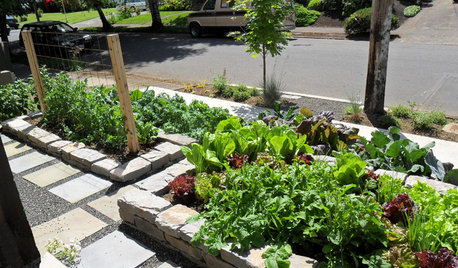Tomatoes w/ Watermelons as Mulch?
shekanahh
14 years ago
Related Stories

EDIBLE GARDENSSummer Crops: How to Grow Tomatoes
Plant tomato seedlings in spring for one of the best tastes of summer, fresh from your backyard
Full Story
FARM YOUR YARDHouzz Call: Home Farmers, Show Us Your Edible Gardens
We want to see where your tomatoes, summer squashes and beautiful berries are growing this summer
Full Story
SUMMER GARDENINGHouzz Call: Please Show Us Your Summer Garden!
Share pictures of your home and yard this summer — we’d love to feature them in an upcoming story
Full Story
FARM YOUR YARDHow to Build a Raised Bed for Your Veggies and Plants
Whether you’re farming your parking strip or beautifying your backyard, a planting box you make yourself can come in mighty handy
Full Story
GARDENING AND LANDSCAPINGWorld of Design: 10 Home Gardeners Show Us Their Sweet Summer Harvests
From New York to Tokyo, these gardeners have turned their yards, terraces and rooftops into places of bounty
Full Story
FARM YOUR YARDHow to Grow Vegetables in Containers
Get glorious vegetables and fruits on your patio with a pro’s guidance — including his personal recipe for potting mix
Full Story
EDIBLE GARDENSHow to Grow Your Own Sweet Summer Crops
This guide will help any gardener get started on growing the freshest warm-season veggies and berries for summer
Full Story
FRONT YARD IDEASWelcome Edibles Into the Front Yard for Fresh Food and More
Give your front yard design a boost and maybe even make new friends by growing fruits and vegetables
Full Story
GARDENING GUIDES10 Easy Edibles for First-Time Gardeners
Focus on these beginner-friendly vegetables, herbs, beans and salad greens to start a home farm with little fuss
Full Story
SAVING WATERXeriscape Gardens: How to Get a Beautiful Landscape With Less Water
Conserve water and make gardening much easier with the xeriscape approach’s 7 principles
Full StorySponsored
Central Ohio's Trusted Home Remodeler Specializing in Kitchens & Baths
More Discussions







Okiedawn OK Zone 7
shekanahhOriginal Author
Related Professionals
Tempe Landscape Architects & Landscape Designers · Lakewood Landscape Architects & Landscape Designers · Hartford Landscape Contractors · Galveston Landscape Contractors · Hicksville Landscape Contractors · Kaysville Landscape Contractors · Rockville Landscape Contractors · West Chester Landscape Contractors · Raytown Landscape Contractors · Bensenville Landscape Contractors · Chandler Decks, Patios & Outdoor Enclosures · Dedham Decks, Patios & Outdoor Enclosures · Frisco Decks, Patios & Outdoor Enclosures · Honolulu Decks, Patios & Outdoor Enclosures · San Diego Decks, Patios & Outdoor EnclosuresOkiedawn OK Zone 7
shekanahhOriginal Author